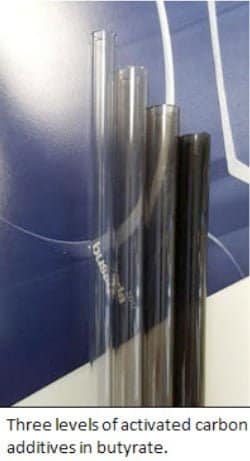Is butyrate an antistat? We get this question often, and the answer is ‘at times’ and ‘no.’
Every winter we receive calls asking for help with static buildup in pneumatic systems. Lower humidity brings an increase in static electricity. In pneumatic systems, you can decrease static charge through increasing the humidity and ionization in the airflow. Products are available to do this (Google “Industrial Static Eliminators”) and you will see a variety of products. On our end, we can use conductive additives to the resin (expensive) and/or coat the outside surface of the tubing (not-so-much). When coated, the tubing can be properly grounded to avoid possible static shocks. Future blogs will address all of these options.
In pneumatic conveying a static electrical charge is usually generated by friction on the interior of the tubing. In steel tubing, the charge is quickly dissipated. But in plastics’ tubing, the charge is usually kept inside the tube. However, in dry conditions, even the outside of the tube can become statically charged. This static charge will be localized. Thus, it may exist in a specific area of the tube as electrons are not free to migrate. A static shock is rare if one were to touch the tube but it can happen.
With 70+ years of extrusion behind us, we firmly recommend cellulose acetate tubing for pneumatic conveyance. Still, we also extrude PC, PETG. Tritan and PVC resins. But, unless one has a specific need tor these resins, we recommend Eastman Tenite Butyrate 576E UV stabilized, and 264E FDA approved resins.
The axiom was, and still is today, “CAB provides the best transparent tubing for pneumatics due to its clarity, cellulosic base, superior impact strength, easy fabrication, and low acoustic resonance.”
However, without additives, no clear, rigid transparent tube meets the criteria for “static dissipative.”
All transparent plastics resins require additives (such as activated carbon, or quaternary amines) to become dissipative. But, additives can alter the transparency as you can see from the picture on the right. And the concentration of carbon needed to achieve static dissipation would make the tube black opaque.
Transparent Butyrate falls into the lower echelon category of “insulative;” but due to its plasticizer and moderate water absorption, it is less insulative than acrylics, polycarbonates, PETG, and PVC as shown below. And as humidity increases butyrate enters the category of “antistat” due to butyrate’s water absorption.
Activated carbon aids the conductivity of the tubing, but at a price. The tubing will no longer be clear.
| Ohms Per Square | Material | Description |
>1013 | Insulative | Insulators and Base Polymers. |
| 109 to1012 | Anti-Static | Initial charges are suppressed. Insulates against moderate to high leakage currents. |
| 105 to10 9 | Dissipative | No or low initial charge. Prevents discharge to or from human contact |
| 103 to105 | Conductive | No initial charge. It provides a path for the charge to bleed off. |
1 to 102 | Shielding |
Usual measurement standards are ASTM D257 and IEC 60093.
Comparison of various materials (mostly transparent) on volume resistivity.
The table below was compiled from Omnexus.
| Polymer | Explicit name of the polymer | Min. Value (1015 Ohm.cm) | Max. Value (1015 Ohm.cm) |
ABS | Acrylonitrile-Butadiene Styrene | 14.000 | 16.000 |
ABS/PC | Acrylonitrile-Butadiene Styrene/Polycarbonate | 14.000 | 17.000 |
CAB | CAB – Cellulose Acetate Butyrate | 13.000 | 13.000 |
COC | Cyclic Olefin Copolymer | 14.000 | 15.000 |
EVA | Ethylene Vinyl Acetate | 15.000 | 15.000 |
PC | Polycarbonate high heat | 15.000 | 16.000 |
PET | Polyethylene Terephthalate | 16.000 | 16.000 |
PMMA | Polymethylmethacrylate (Acrylic) impact modified | 14.000 | 16.000 |
PS Crystal | Polystyrene crystal | 16.000 | 17.000 |
PVC | Polyvinyl Chloride rigid | 15.000 | 16.000 |

